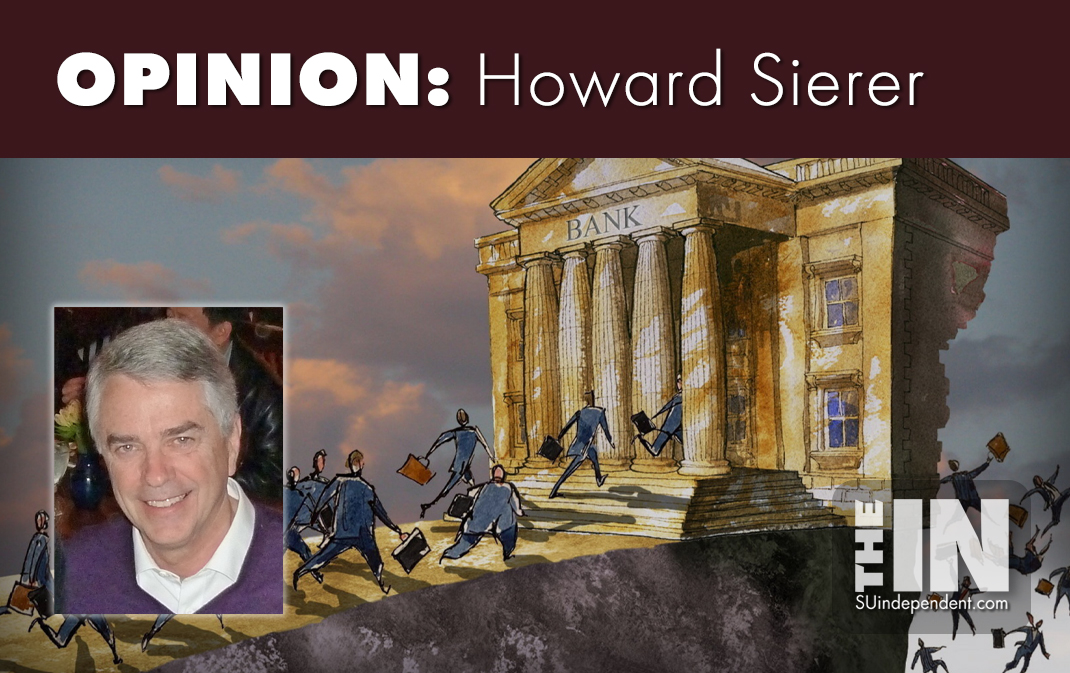
Biden Owns This Banking Crisis
– By Howard Sierer –
Today’s worldwide banking crisis is easily and directly attributable to Pres. Biden’s post-election decision to abandon his promises to be a moderate consensus builder and instead govern as a full-blown, far-left progressive.
Step 1. Biden gave his approval to wildly excessive spending, wanting to be known in history as a transformative president in the mold of Franklin Roosevelt. Right out of the chute, he joined with the Democratic-controlled Congress to pass the completely unneeded $1.9 trillion American Rescue Plan at a time when the economy was booming back from COVID. Why? Democrats didn’t want Trump and the Republicans to get credit for the recovery, and handing out “free” money was seen as a political winner.
Step 2. The Federal Reserve – encouraged by the White House, congressional Democrats, and liberal economists – claimed that the inflation evident to all in late 2021 was “transitory” and would abate in 2022. This, despite persistent warnings that zero interest rates coupled with massive deficit spending would ignite serious inflation. Hence, the Fed kept interest rates near zero for far too long.
Step 3. Ignoring warnings from a variety of responsible sources that continued spending would lead to inflation, Biden and his progressive acolytes in Congress poured on the intentionally-misnamed 2022 “Inflation Reduction Act.” The act was little more than a $391 billion green energy spend-a-thon plus additional Obamacare subsidies. Its supposed deficit-reducing tax increases will not occur for years.
Step 4. In December 2022, more new-program spending was included in the $1.7 trillion Consolidated Appropriations Act despite the highest inflation in decades. Having lost the House of Representatives starting in 2023, the progressive minority that controls the Democratic Party knew that this was their last chance for unrestrained spending.
Step 5. To fund all these spending blowouts, the Treasury Department sold government notes and bonds, adding $3.6 trillion to our national debt during the Biden administration’s first two years. To preserve its ill-advised zero-interest rate policy, the Federal Reserve Bank printed money to buy the lion’s share of the debt, thereby feeding trainloads of cash into the economy.
Step 6. Unrealistically low-interest rates allowed the Treasury to finance the rapidly growing national debt without boosting its interest payments to bondholders. Public buyers of bonds were forced to choose between interest rates on short-term government debt that were less than the supposed “transitory” inflation rate or to buy 10-year or 30-year bonds with slightly higher rates.
Step 7. Enter Silicon Valley Bank and others. SVB was deluged with deposits from venture capitalists and lavishly-funded startup tech companies that flourished during pandemic remote work-from-home lockdowns. SVB’s assets grew from $71 billion in January 2020 to $212 billion in January 2023. Unable to find borrowers for all these deposits, SVB management chose to put a large fraction of these funds in ultra-safe, long-term government bonds. What could go wrong?
Step 8. By the summer of 2022, the Federal Reserve came to its senses, recognizing that 9% inflation wasn’t transitory and that its easy money/low-interest rate policy, coupled with Democrats’ over-the-top spending, had created an inflation monster. The Fed’s response was the most rapid rise in short-term interest rates in 40 years.
Step 9. Those rising interest rates devalued previously issued bonds. For example, banks like SVB that had purchased new 30-year Treasury bonds for $10,000 in November 2021 received a yield of 1.94% or $194 per year. By November 2022, a bank need only purchase $5,000 in new bonds yielding 4.00% to earn $200 per year. A bank holding 2021 bonds could only sell them on the open market for that $5,000 or half their original price. As of this month’s prices for those long-term bonds, the nation’s banks collectively have lost about $2 trillion.
Step 10. Government-approved accounting rules allow banks to value government bonds at their face value on their books, not their current market value. As long as interest rates remain fairly steady, this rule makes sense.
Step 11. The actual value of SVB’s massive long-term government bond holdings had dropped significantly, imperiling the bank’s viability. Nonetheless, it was allowed to continue reporting their worth at face value, hoping that rates would drop and raise their actual value. Selling them would incur a substantial loss.
Step 12. SVB’s required reporting of its financial holdings in January 2023 revealed its problem: government bond holdings worth far less than their reported value. As Warren Buffett observed, when the tide goes out, we find out who has been swimming naked.
Step 13. Venture capitalists began advising their clients to move their deposits out of SVB since only the first $250,000 is government insured. This precipitated a “run” on the bank: depositors demanding more cash than the bank had on hand. To raise cash, it would have to sell bonds at a large loss, likely leading to bankruptcy.
Step 14. While the federal government stepped in to protect all depositors (with more printed money) regardless of how much money they had in the bank, customers all around the country and the world started looking at other banks to see who would be next to succumb to massive losses on their government bond holdings. The result: a government-created, full-fledged crisis of confidence in the world’s banks.
Biden owns it all, from massively excessive government spending to causing a huge boost in government borrowing funded with money printed by the Federal Reserve, to the highest inflation in 40 years, to rapidly increasing interest rates, to a worldwide banking crisis.
Will congressional Democrats ever learn there is no free lunch? Don’t hold your breath.
Viewpoints and perspectives expressed throughout The Independent are those of the individual contributors. They do not necessarily reflect those held by the staff of The Independent or our advertising sponsors. Your comments, rebuttals, and contributions are welcome in accordance with our Terms of Service. Please be respectful and abide by our Community Rules. If you have privacy concerns you can view our Privacy Policy here. Thank you!
Click here to submit an article, guest opinion piece, or a Letter to the Editor





Now I get it! Your explanation of the bond problem and number 9 is great.